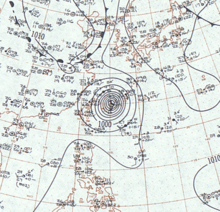 Surface weather analysis of Typhoon Sarah on September 15 | |
| Meteorological history | |
|---|---|
| Formed | September 11, 1959 |
| Extratropical | September 19, 1959 |
| Dissipated | September 23, 1959 |
| Typhoon | |
| 10-minute sustained (JMA) | |
| Lowest pressure | 905 hPa (mbar); 26.72 inHg |
| Category 5-equivalent super typhoon | |
| 1-minute sustained (SSHWS/JTWC) | |
| Highest winds | 305 km/h (190 mph) |
| Overall effects | |
| Fatalities | Around 2,000 |
| Damage | $102 million (1959 USD) |
| Areas affected | Japan, South Korea, Soviet Union |
| IBTrACS | |
Part of the 1959 Pacific typhoon season | |
Typhoon Sarah, known as the Miyakojima Typhoon in Japan, was a destructive typhoon, and among the deadliest on record in the western Pacific Ocean, killing around 2,000 people. It formed during the peak of the busy 1959 Pacific typhoon season near Guam, and moved generally to the west-northwest. Continued observations from the hurricane hunters allowed the Joint Typhoon Warning Center (JTWC) to track Sarah from its origins to its peak as a powerful typhoon, with maximum sustained winds estimated at 305 km/h (190 mph) on September 15. Shortly thereafter, the typhoon struck the small Japanese island of Miyako-jima, where the barometric pressure fell to 908.1 mbar (26.82 inHg), the second-lowest on record for the country. Sarah turned to the north and northeast, weakening from its peak intensity. On September 17, the typhoon made landfall just west of Busan, South Korea with winds of 185 km/h (115 mph), the nation's strongest landfall at the time and only to be surpassed by Typhoon Maemi in 2003. Sarah later became extratropical over the Japanese island of Hokkaido on September 18, although the remnants persisted for several days, crossing into the Russian Far East and later dissipating on September 23.
On Miyako-jima, Sarah damaged all of the crops and destroyed about 6,000 houses. Damage was estimated at $2 million,[nb 1] and there were seven deaths. The damage prompted the Japan Meteorological Agency to give Sarah the special name of the "Miyakojima Typhoon". However, the effects were worst in South Korea, and Sarah was described as the worst typhoon there in 50 years. Wind gusts there peaked at 169 km/h (105 mph), the highest at the time in the country. High winds and waves heavily damaged the port of Busan. Nationwide, the storm destroyed over 14,000 homes and left 782,126 people homeless, causing over $100 million in damage. At least 669 people were killed in South Korea, and an additional 1,200 fishermen were lost offshore the country. In Japan, widespread flooding killed 47 people and destroyed 16,632 homes.
Cite error: There are <ref group=nb> tags on this page, but the references will not show without a {{reflist|group=nb}} template (see the help page).
© MMXXIII Rich X Search. We shall prevail. All rights reserved. Rich X Search
